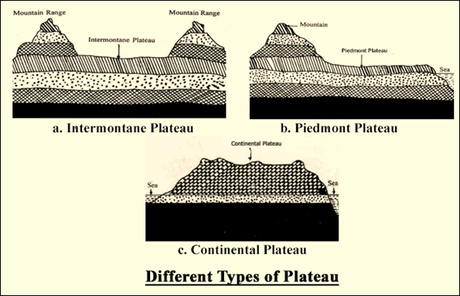Jharkhand, located in the eastern region of India was carved out from the state of Bihar on 15th November 2000. Jharkhand is known as the 'Land of forest' or 'Bushland' as 29.55% of the total area of the state is covered under forest.
The word Jharkhand is derived from the Indo-Aryan language where 'Jhar' means 'Bush' and 'Khand' means 'Land'. The state is rich in mineral resources and contributes more than 40% of the total mineral resources of India.
Jharkhand is often referred to as the Chota Nagpur because the plateau of Chota Nagpur mostly comprises of the state of Jharkhand.Keep reading to know more about Chota Nagpur Plateau.
Table Of Contents
Where Is Chota Nagpur Plateau Located?
It also covers some parts of Odisha, West Bengal, and Chhattisgarh. The total area that comes under the Chota Nagpur Plateau is approx 65,000 square kilometers. The plateau is bordered by Indo-Gangetic plain on North and East and by the basin of river Mahanadi on the south.
What Is A Plateau?
Plateau, also known as high plain or tableland is a plain area consisting of flat terrain that rises above the adjacent areas and is mostly bordered by hills on its one or more sides.

Types of Plateaus
Plateaus are generally classified into four subcategories
Intermontane Plateaus
Intermontane plateaus are the highest plateau in the world and are bordered by mountains. An example of the Intermontane plateau is the Tibetan Plateau.
Lava or Volcanic Plateaus
Lava or Volcanic Plateaus are the types of plateaus that are formed due to volcanic eruptions. An example of a Lava or Volcanic plateau is Deccan Plateau.
Piedmont Plateaus
Piedmont Plateaus are the type of plateaus that are bordered by mountains on one side and by a plain or sea on another side. An example of Piedmont Plateaus is Piedmont of the Eastern United States.
Continental Plateaus
Continental Plateau is the types of plateaus which are bordered by mountains or season all its sides. An example of Continental Plateau is Antarctic Plateau in East Antarctica.

Which Type Of Plateau Is Chota Nagpur?
Chota Nagpur Pleatue is a type of Continental Plateau with Indo-Gangetic plain on its north and the basin of river Mahanadi on its south.
How Chota Nagpur Plateau Was Formed?
Deccan Plateau is formed as the plain was uplifted due to the pressure building up deep inside the earth. The plateau is considered to be a part of the Deccan plateau which broke off from the Southern Continent during the geological period of Cretaceous and set on a 50 million years journey till it collided with the continent of Eurasia, comprising of the continents of Europe and Asia.
The Chota Nagpur plateau broke off from the main mass of Deccan Plateau and traveled further east of the continent.
How Did Chota Nagpur Plateau Get Its Name?
Chota Nagpur Plateau got its name as 'Nagpur' from the 'Nagvanshis' who ruled the region for quite a time, and 'Chota' which means 'small' from a village named Chota located at the outgrowths of Ranchi, where an old fort of the Nagvanshis ruler exist.
How is Chota Nagpur Plateau Classified?
Chota Nagpur Plateau is further classified into seven sub-category

Pat Region
Pat region comprises of the Surguja district of Chhattisgarh, having an average height of 3,300 ft and a few part of Jharkhand. Pats are basically the flat top region of the plateaus and can be identified as a part of the main plateau by their elevations. The region is also sometime refers to as Western Ranchi Plateau. The Queen of Chota Nagpur, Netarhat comes under the Pat region.
Ranchi Plateau
Ranchi Plateau forms the largest part of the Chota Nagpur and has an average height of 2,300 ft. The plateau cautiously slope down into the Kolhan region which comprise of the East Singhbhum, West Singhbhum and the Seraikela Kharsawan district.
The rivers flowing through the region creates a large number of waterfalls as they slope down from the plateau.
Waterfalls In The Ranchi Plateau
Hazaribagh Plateau
Hazaribagh Plateau comprises of the town of Hazaribagh and is separated from the Ranchi Plateau by the Damodar Trough. The Hazaribagh Plateau is bordered by hills on all its sides.
Hills In The Hazaribagh Plateau
- Jilinga Hills
- Mahabar Jarimo Hills
- Barsot Hills
- Sendraili Hills
- Mahuda Hills
Koderma Plateau
The Koderma Plateau is the lower region of the Hazaribagh Plateau and therefore is also known as Lower Hazaribagh Plateau. It is also known as the Chauparan-Koderma-Giridih Plateau as it covers the town of Chauparan in the Hazaribagh district, the entire of Koderma and Giridih. The rivers in the sub plateau of Koderma also creates waterfalls.
Waterfalls In Koderma Plateau
Damodar Trough
The Damodar basin creates a trough between the sub plateau of Ranchi and Hazaribagh causing the land between to sink which further preserves the Karanpura, Ramgarh and Bokaro coalfields from wearing away.
Palamu
The Palamu region comprises of three districts of Jharkhand, Garhwa, Latehar and Palamu. The hills in the region run parallel from east to west giving way to the North Koel river. The Palamu region gives birth to the highest waterfall of Chota Nagpur plateau, the Lodh Falls and few other falls.
Waterfalls In The Palamu Region
Manbhum-Singhbhum
Manbhum - Singhbhum is the lowest region of the Chota Nagpur plateau. The Malbhum region covers the district of Purulia in West Bengal and districts of Dhanbad and Bokaro in Jharkhand.
The Singhbhum region, currently known as the Kolhan region comprises of the districts of East Singhbhum, West Singhbhum, and Seraikela Kharsawan. The average elevation of the Malbhum region is 1000 ft and that of the Singhbhum is 3000 ft.
The Singhbhum region or more broadly the Kolhan region is a hilly region as compared to the Manbhum region, with the Dalma hills surrounding the city of Jamshedpur.
What Minerals Are Found In The Chota Nagpur Region?
The Chota Nagpur Plateau has abundance of minerals. Some of the minerals found in the region are mica, bauxite, copper, limestone, iron ore and coal.
Eco Region Of The Chota Nagpur Plateau
The eco region of Chota Nagpur Plateau spreads over an area of 122,100 square kilometers covering mainly the state of Jharkhand and few parts of Odisha and Chhatisgarh. Approx 6 percent of the entire ecoregion of the Chota Nagpur Plateau which comprises 6,720 square kilometers comes under the protected area.
Protected Areas In Chota Nagpur Plateau
- Betla National Park
- Bhimbandh Wildlife Sanctuary
- Dalma Wildlife Sanctuary
- Gautam Buddha Wildlife Sanctuary
- Hazaribag Wildlife Sanctuary
- Koderma Wildlife Sanctuary
- Lawalong Wildlife Sanctuary,
- Ramnabagan Wildlife Sanctuary
- Sanjay National Park
- Semarsot Wildlife Sanctuary
- Simlipal National Park
- Saptasajya Wildlife Sanctuary
- Tamor Pingla Wildlife Sanctuary
- Topchanchi Wildlife Sanctuary
Hills and Mountain Ranges In Chota Nagpur Plateau
The plateau of Chota Nagpur is mostly covered with hills and forests. Here is a list of hills in Chota NagpurPlateau

